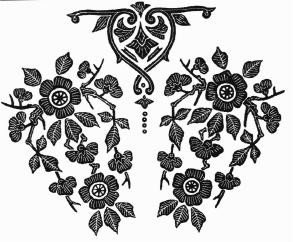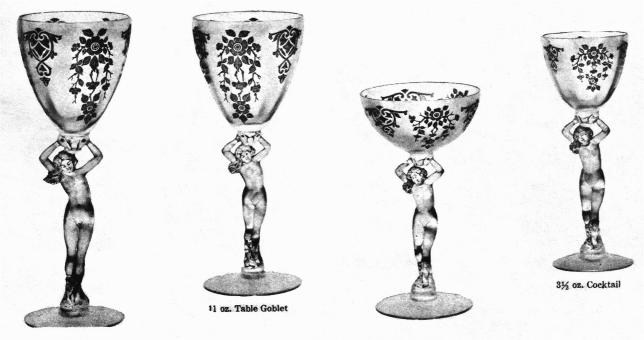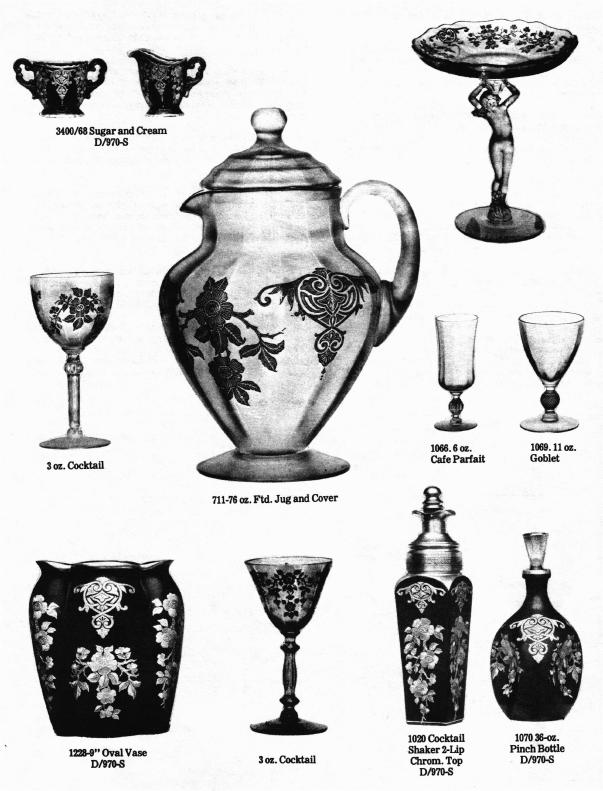Apple Blossom
by Mark A. Nye
Issue No. 124 - August 1983
We depart this time from the Cambridge "girls" and turn to the Cambridge "garden" for a topic. The "girls" will return in a future issue.
 Unlike the natural flower of the apple tree, Cambridge Apple-Blossom
or Plate Etching No. 749 comes in a wide range of colors and some
special treatments. Colors known to this writer are Crystal, Gold
Krystol, Willow-Blue, Amber, Emerald (light or Apple Green),
Heatherbloom, Peach-Blo, Forest Green, Amethyst, Ebony and Royal Blue.
The latter three colors, at least, were used in conjunction with silver
encrustation of the etching. It is possible metallic encrustation was
done on other colors as well.
Unlike the natural flower of the apple tree, Cambridge Apple-Blossom
or Plate Etching No. 749 comes in a wide range of colors and some
special treatments. Colors known to this writer are Crystal, Gold
Krystol, Willow-Blue, Amber, Emerald (light or Apple Green),
Heatherbloom, Peach-Blo, Forest Green, Amethyst, Ebony and Royal Blue.
The latter three colors, at least, were used in conjunction with silver
encrustation of the etching. It is possible metallic encrustation was
done on other colors as well.
Silver encrusted Apple-Blossom was referred to as D/970-S and is shown on Ebony ware on several pages of the 1930-34 Cambridge catalog as reprinted by the NCC, Inc. Pictured are such items as the #3400/68 sugar and creamer, #1020 cocktail shaker, #1070 36 oz. pinch bottle, #1228 9" oval vase and several bowls. Some are shown in the illustration at the end of this article.
Page 31-13 of the 1930-34 catalog reprint is entitled "Silver Decorated Ware." There is no mention of color but since there is duplication of items found in the Ebony/silver encrusted section of preceding pages, these were probably being offered in at least Amethyst and perhaps other colors. An advertisement in the August 1931 issue of Crockery and Glass Journal promotes silver encrusted Apple-Blossom as "offered in a wide selection of table pieces."
I have in my collection a #646 5" candlestick, (keyhole style, single light), in Royal Blue with the Apple-Blossom etching silver encrusted. This is the first piece of this color I have seen with the Apple-Blossom etching and do not know to what extent this etching was used on Royal Blue. My guess is very little was done and all would have been silver or gold encrusted.
Dinnerware or luncheon sets are known in all of the colors previously listed with the exception of Forest Green, Ebony and Royal Blue. The pieces I have seen in Forest Green have been occasional, accessory or service items, for example, the #3400/94 3½" puff box and #3400/38 80 oz. ball shaped jug. Ebony Apple-Blossom, most of which if not all, would have been metallic encrusted, was apparently limited to the type of items shown in the 1930-34 catalog reprint. Royal Blue production was probably limited to vases, candlesticks and console bowl. All of the remaining colors would also have been used for a wide range of occasional, accessory, service or decorative items.
The 1930 Cambridge catalog devoted the first nine pages to the Apple-Blossom etching, 7 of which show items from the #3400 line and 2 were used to picture the nos. 3135 and 3130 stemware and 2 jugs. From the #3400 line are shown various accessory pieces such as console bowls, candlesticks, comports and the #3400/9 candy box and cover, in addition to dinnerware. Both styles of the #3400 plates, round and square are shown with the etching, as is the club luncheon plate, #3400/66. (This latter piece was recently seen in Gold Krystol.) Two styles of creamers and sugars, nos. 3400/16 and 3400/68, the #3400/52 butter and cover along with serving bowls, relishes and platters are also shown as are the cream soup with saucer, cereal bowl, fruit saucer and the #3400/54 cup and saucer.
While all of the dinnerware etched Apple-Blossom shown in the 1930-34 catalog reprint and that I have seen, has been from the 3400 line, it is possible other blanks might have been used. However, production would have been limited since the #3400 line was the primary blank used for this etching.
So far, I have been able to identify 9 Cambridge stemware lines that were etched Apple-Blossom. These are the nos. 1069, 3011, 3025, 3120, 3124, 3130, 3135 and 3400. Each of these will be discussed.
By now, I am sure everyone is aware of the Apple-Blossom etched goblet that is shown in the popular book dealing with Fostoria glassware. At first glance, the item appears to be a #1066 goblet but careful study of the stem portion and the "ball" in particular, reveals the apparent absence of vertical dividing lines in the "ball." In the 1930-34 catalog reprint are 2 illustrations of a #1069 11-oz. goblet, once on page 33-21 and again on page 33-B-4. This goblet appears to be similar to the #1066 line except for the lack of vertical dividing lines in the "ball." Thus, it is my opinion the pink goblet etched Apple-Blossom in the Fostoria book is a #1069 goblet and not from the #1066 line. I am not aware of any other stemware from either line with this etching. It is possible the etching was used on the #1066 line since other etchings were applied to this stemware. See photos.
Shown in the reprinted 1931 catalog supplement (at the end of this article) are the #3011 or nude banquet goblet, table goblet, tall sherbet or champagne, cocktail (3011/9) and the 7" cupped comport, etched Apple-Blossom. (See photos.) In the articles on the nude stem line by Hughes and Welker, previously published in the Crystal Ball, reference is made to wines and clarets etched Apple-Blossom, as well as to the sweetmeat. No specific information regarding colors was supplied by these authors except that reference to tall comports, cupped and flared, in Crystal and colors, is made.
A complete selection of #3130 stemware was produced with the Apple-Blossom etching, in at least 5 colors, 1 color combination and a special treatment. The known colors are Crystal, Emerald (light), Gold Krystol, Peach-Blo and Willow Blue; with the bowl, stem and foot all the same color. The one color combination known consists of Crystal bowl with Ebony stem and foot. A Crystal #3130 footed tumbler is known with the medallion portion of the pattern encrusted gold and black. It is possible Amber #3130 stemware was etched Apple-Blossom, although I am not personally aware of such being found. See photos.
Apple-Blossom etched #3135 stemware may be found in Crystal, Emerald (light), Peach-Blo and Willow-Blue. In all probability, this line was also done in other colors, particularly Gold Krystol and Amber, with this etching. All pieces seen have been solid color or all Crystal. (See photos.)
The #3400 line of stemware, etched Apple-Blossom, with colored bowl, stem and foot, is known in Amber, Emerald (light), Gold Krystol, Peach-Blo and Willow-Blue. This line was also produced in all Crystal and Crystal bowl with Ebony stem and foot with the etching. Other colors are possible. (See photos.)
The #3025 stemware etched Apple-Blossom no doubt came in the pastel colors of the 1930-34 period but I have been unable to find a reference to document which colors were used nor have I seen the line with this etching. It is shown in the 1931 catalog supplement but the general catalog contained only a general reference to color, no specific were provided, such information being contained in the price lists.
Use of the Apple-Blossom etching on the #3120 and #3124 stemware lines has been reported by a collector of this pattern and who owns examples. The #3120 piece is in Crystal and a #3124 champagne is in Gold Krystol. No doubt other colors were used for both lines.
Another collection contains #3035 stemware in Heatherbloom and the Apple-Blossom etching. Whether this stemware line in other colors was used in conjunction with this etching is not known but cannot be ruled out. This same stemware in Heatherbloom is also known with the Gloria etching.
Six styles of Apple-Blossom etched pitchers or jugs, as they were called by Cambridge, are shown in the 1930-34 catalog reprint and no doubt other jugs from the era were also decorated with this etching. Those shown are the #711 76 oz. footed jug and cover, #1205 64 oz. jug, #3400 50 oz. footed jug, #935 64 oz. jug, #3400/38 80 oz. ball-shaped jug, and the #3400/27 67 oz. jug. All of these would have been produced in Crystal and color.
Vases are also a part of the Apple-Blossom story. Among those shown in the 1930-34 catalog reprint are the #1300-8" and #1283-8", both of which appear to be in Crystal with an Ebony base; #1304-10", #1308-6", #1234-12", #1309-5" and the #1296-12". It can be assumed, with some degree of confidence, that many of the other vases illustrated were also produced with the Apple-Blossom etching. As with the jugs, vases would have been produced in color as well as Crystal.
The #693/3000 2 piece canapé set is to be found with the Apple-Blossom etching, as are decanters, ice buckets and other snack and beverage accessory items. It is interesting to note that the canapé plates in my collection have a Laurel Wreath band on the rims, in addition to the Apple-Blossom etching on the flat part of the plates.
Recently seen were a pair of boudoir lamps incorporating Amber #1309 vases, etched Apple-Blossom, as the main portion of the lamp base. These would not have been assembled by Cambridge but rather by some lighting company, whose identity remains unknown.
A blown #3121/4 low candy box and cover in Crystal and etched Apple-Blossom has been acquired for my collection. For those who are unfamiliar with this piece, both the lid and box are blown and etched.
Since Apple-Blossom was an important etching in the Cambridge line during the early 1930s, a collector should not be surprised to find the etching on almost any piece of the #3400 line in production during that era, or for that matter, perhaps on any piece or line produced during those years and to which the etching was adaptable and compatible.
First introduced in 1930, the Apple-Blossom etching was discontinued prior to 1940, most likely in the mid 1930s. Later, the name Apple-Blossom was used for a silk screen decoration of entirely new design not associated with the earlier etching.
If any reader has additional information regarding this etching or those discussed in earlier article, or wishes to correct errors of commission or omission, please do not hesitate to write me in care of the Crystal Ball. I will share all information received in a future article. Comments are also invited in the form of letters to the editor.


